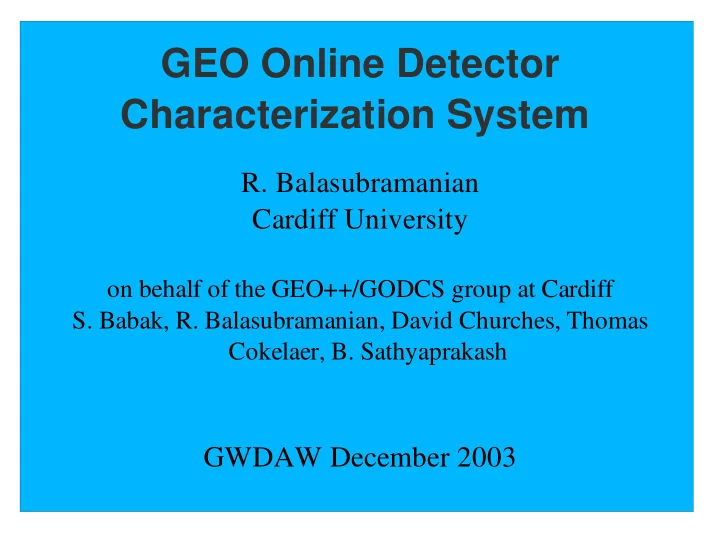

GEO Online Detector Characterization System R. Balasubramanian Cardiff University on behalf of the GEO++/GODCS group at Cardiff S. Babak, R. Balasubramanian, David Churches, Thomas Cokelaer, B. Sathyaprakash GWDAW December 2003
GODCS ARCHITECTURE RAW FRAME DATA GODCS MONITORS Main GW channel and other instrumental monitors and Monitors process the various environmental channels. channels and look for glitches, line amplitude fluctuations, Band limited RMS fluctuations etc. They also measure linear and non linear Interactive and visual data mining using coupling between any pair of TRIANA. Complex questions regarding the channels. state of the detector can be translated to complex queries to the database. Involving multiple tables. MySQL Database Events are recorded into tables like Glitch, powerTracker etc.
GODCS ARCHITECTURE Monitor Overseer. Oversees execution of monitors MPI Frame M M M Monitor Archive Server Communicates With clients Using MPI Monitor Overseer. Library Oversees execution of monitors MPI Distributes Data to clients M M And inserts Records given By the various Database clients Monitor Overseer. Oversees execution of monitors MPI M M M M
GODCS TASK DEFINITION ● Purpose is to characterize the noise in the detector and to aid in obtaining reliable veto channels. ● To check if excess noise in the main GW channel can be related to any environmental source. ● Results are stored in a MySQL database which is a very systematic way of storing results. ● The database results are visualized using TRIANA which is a visual programming environment. ● Complex relationships amongst various channels can be translated to complex queries to the database.
Monitor Descriptions I SaturationMon GlitchMon Checks if any channel Looks for Glitches in saturates the ADC the data. Time domain algorithm. PowerTrackerMon LineDetectMon Tracks band limited RMS Identifies line sources averages for several of noise. frequency bands.
Monitor Descriptions II BicoherenceMon CoherenceMon Measures Bicoherence/Cross Bicoherence between 2 Measures the coherence channels with user defined between any pair of frequency ranges. channels at specific frequencies and records an excess coherence HACRMon “event” into database. GEO++ Implementation of TFCLUSTERS algorithm. InspiralSenseMon Tracks the sensitivity of the InspiralSearchMon detector to Inspiralling Uses matched filtering to binary systems. This is done search for Inspiralling for 3 binary systems namely binaries. (Uses LAL code) NS-NS, BH-BH and BH-NS.
InspiralSenseMon
HACRMon
Status ● Was operational during S1 and first week of S3 ● LinedetectMon was useful in identifying lines and measuring shifts in frequency ● Could independently measure microseismic coupling into interferometer output. ● Ongoing effort to make dataminig more user friendly
Data Mining With Triana ● A visual Programming environment ● Interfaces to databases and frame data ● Graphers and other visualization units ● Data processing units to reproduce monitor results ● Can handle a wide variety of data types and hence and handle data mining tasks efficiently.
Recommend
More recommend